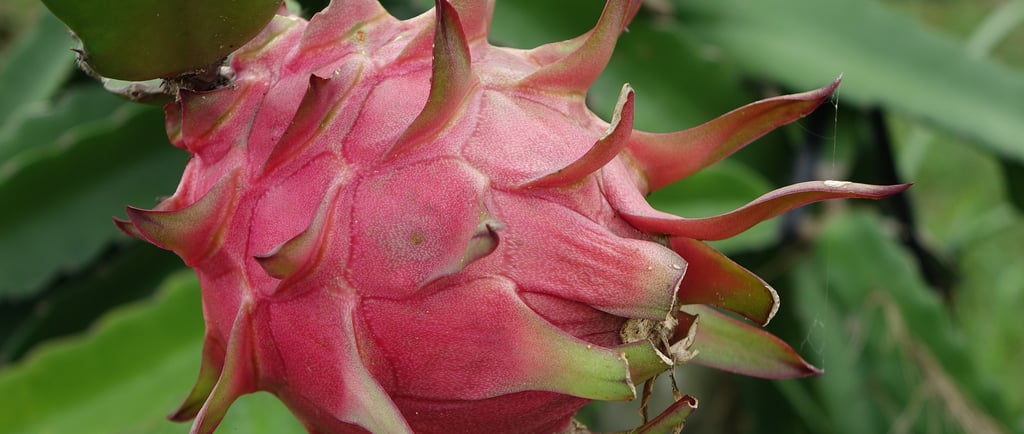🌙 Night Blooms and Dragon Dreams 🌵 The Dragon Fruit 🐉
This story links to two chapters in Biology—the chapter on Types of Fruits 🍎🍇 and the chapter on Ecology 🌍🌿, where we discuss how plants adapt to different environments. Dragon fruit grows on a cactus, and cactuses are fascinating plants that have evolved incredible ways to survive in dry, desert-like conditions. 🌵✨ Their thick, fleshy stems store water 💧, their spines help reduce water loss 🌞, and they rely on unique pollinators, like bats 🦇 and moths 🦋, to help them reproduce. Just like spices and other fruits, dragon fruit has traveled across ancient trade routes 🌍, spreading flavor 🍴 and beauty 🌸 around the world. This story invites children to explore and ask questions about fruits growing on cactuses. 🌵 Dragon fruit isn’t alone—other fruits grow on cactuses too! I wonder… are they too classified as berries? 🍇🥝
BIOLOGY STORIES
12/30/20243 min read


Let’s think about types of fleshy fruits! You already know about berries, drupes, pomes , pepos, hesperdium, agregate and composite fruit? ( Here you will discover what you need to revisit ) But what if I told you about a fruit that looks like it came straight out of a fairy tale? Its skin is bright pink with green spikes, and inside it holds sweet, juicy secrets and thousands of black seeds. Can you guess what's this fruit?
Today, I brought this magical fruit—Dragon Fruit! 🐉✨ Dra 👏 gon 👏 Fruit 👏
Dragon fruit has another name—pitaya! 👏 Pi 👏 ta 👏 ya 👏The name pitaya comes from the Taíno word for “scaly fruit,” referring to its spiky, dragon-like skin. ( Pass the fruit around and let children touch the scales—what do they feel like? Smooth? Bumpy? Like dragon scales?)
This magnificent fruit grows on a cactus plant. 🌵 Yes, a cactus! Unlike the prickly kind you see in deserts, this cactus produces stunning, night-blooming flowers that only open under the moonlight—like a secret midnight party! 🌙✨And here’s something amazing: the flowers can be as big as your head! 🌸 After the flowers are pollinated, the fruit begins to grow, but it takes patience—about 30 days for the fruit to ripen fully. Isn’t that amazing? A whole month to become sweet and delicious! 🍎⏳
Do you know who helps pollinate the dragon fruit cactus? Bats 🦇 and moths! They visit the flowers at night, sipping nectar and carrying pollen from one bloom to another. Without these little night owls, dragon fruit wouldn’t grow. When the fruit ripens, birds 🐦 and small mammals enjoy nibbling on it, helping spread its seeds to new places.
Dragon fruit is a type of berry, a fruit with a soft, fleshy inside and tiny seeds throughout. Its white, pink, or even red flesh is speckled with tiny black seeds that you can eat—just like a kiwi! 🥝✨Can you think of other berries? Tomatoes, blueberries, grapes… and now dragon fruit joins the club! Now, let's see what it looks like inside. (Cut open the fruit here and pass it around for children to observe, touch, and smell.)
Now here’s something fun: Dragon fruit knows exactly when it’s ready to eat! When the fruit ripens, its bright green scales start to turn yellowish-green, and the skin softens slightly—just enough to let you know it’s sweet and juicy inside. If you pick it too soon, it might not taste as sweet, but wait too long, and it gets too mushy. It’s like the fruit has its own timer! ⏱️✨
This fruit first grew in Central and South America, where it was treasured by the Aztecs for its sweet taste and vibrant color. Later, it traveled to Asia along ancient trade routes. 🌍 Today, dragon fruit is widely grown in countries like Vietnam, Thailand, and the Philippines. Want to know something cool? In Vietnam, dragon fruit is called thanh long, which means “green dragon,” inspired by its spiky, dragon-like skin. 🐉✨
Dragon fruit isn’t just a treat for bats and birds; it’s a delicious dessert for humans too! Its flesh is rich in antioxidants, which protect your body from getting sick, and it’s high in vitamin C, making it great for your skin and your body’s department of defense—the immune system. 🌿💪 In some cultures, it’s even believed to bring good luck and prosperity people say that you will have as much luck during the year as the seeds in the flesh of the fruit. And let’s not forget—it’s so beautiful that people use it to decorate fancy dishes and desserts. 🍨✨ It looks like a dessert with sprinkled sesame seeds inside.
I wonder..What other fruits do you know that grow on a cactus plant?
Possible Follow-up Explorations:
Art 🎨
Create a botanical drawing of dragon fruit using vibrant colors. Focus on its unique spiky skin, flowers, and the speckled flesh inside.
Geography 🗺️
Research countries where dragon fruit grows, like Vietnam, Thailand, and Mexico. Use a map to track its journey from Central America to Asia. Visit the grocery store to see where your dragon fruit is imported from!
Community Building 🧑🍳
Host a dragon fruit taste test! Children can research recipes like dragon fruit smoothies, salads, or desserts, and present their creations to the community.
Biology 🌱
Plant dragon fruit seeds and observe the germination process. Learn how cacti adapt to their environments and how dragon fruit’s cactus plant thrives in tropical climates.
With Montessori joy,
Vanina 😊

